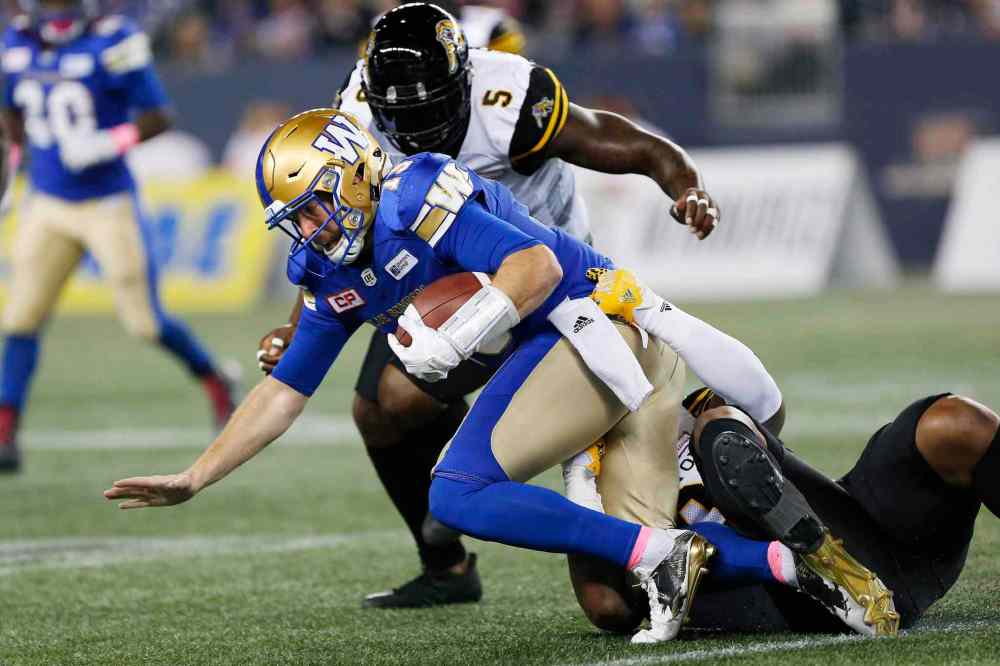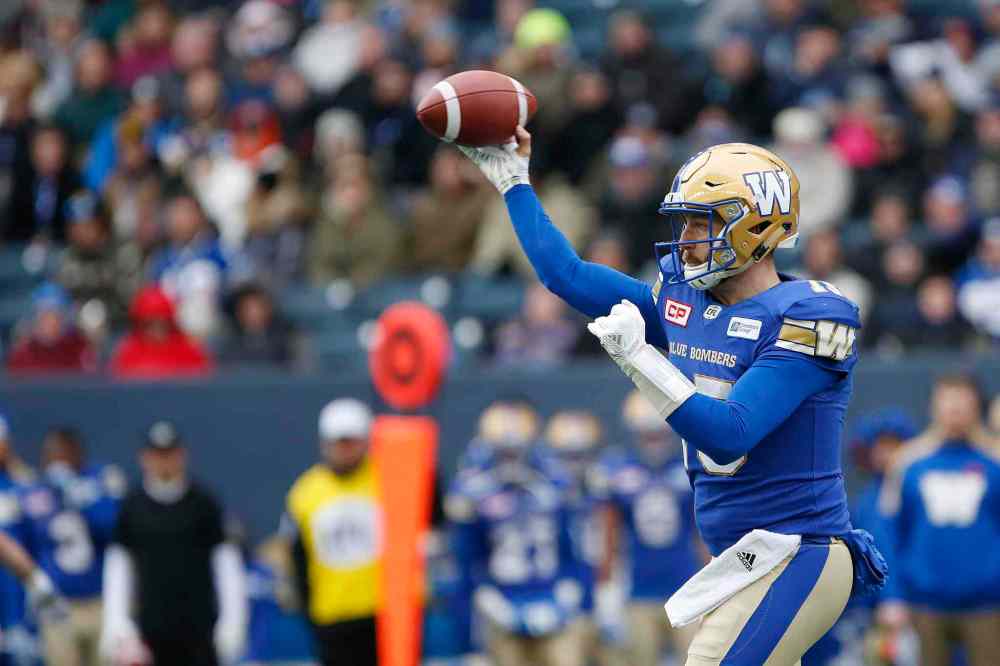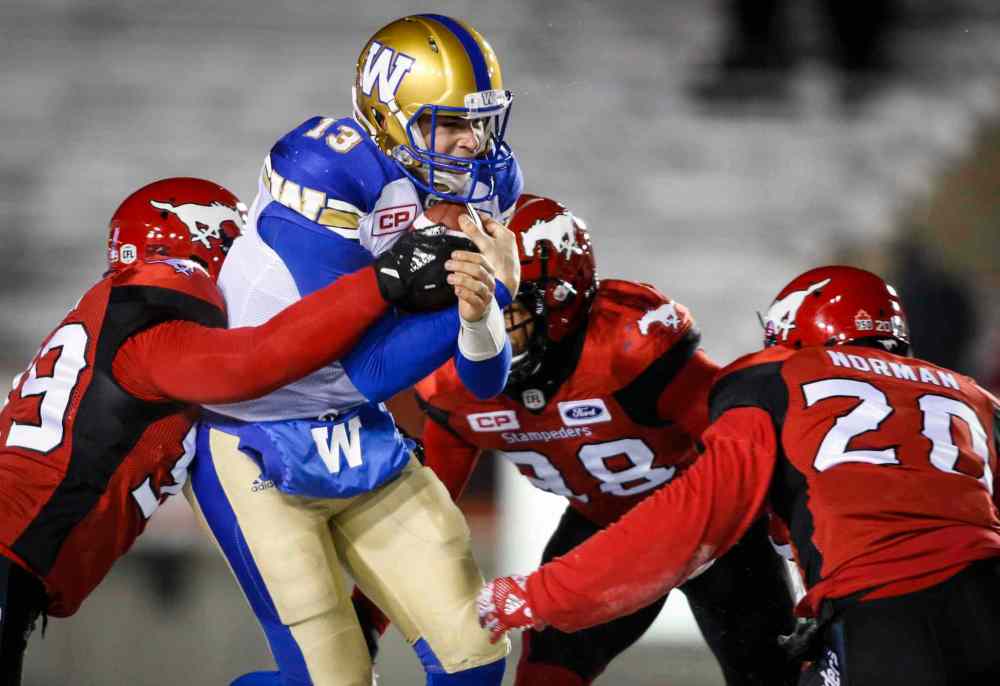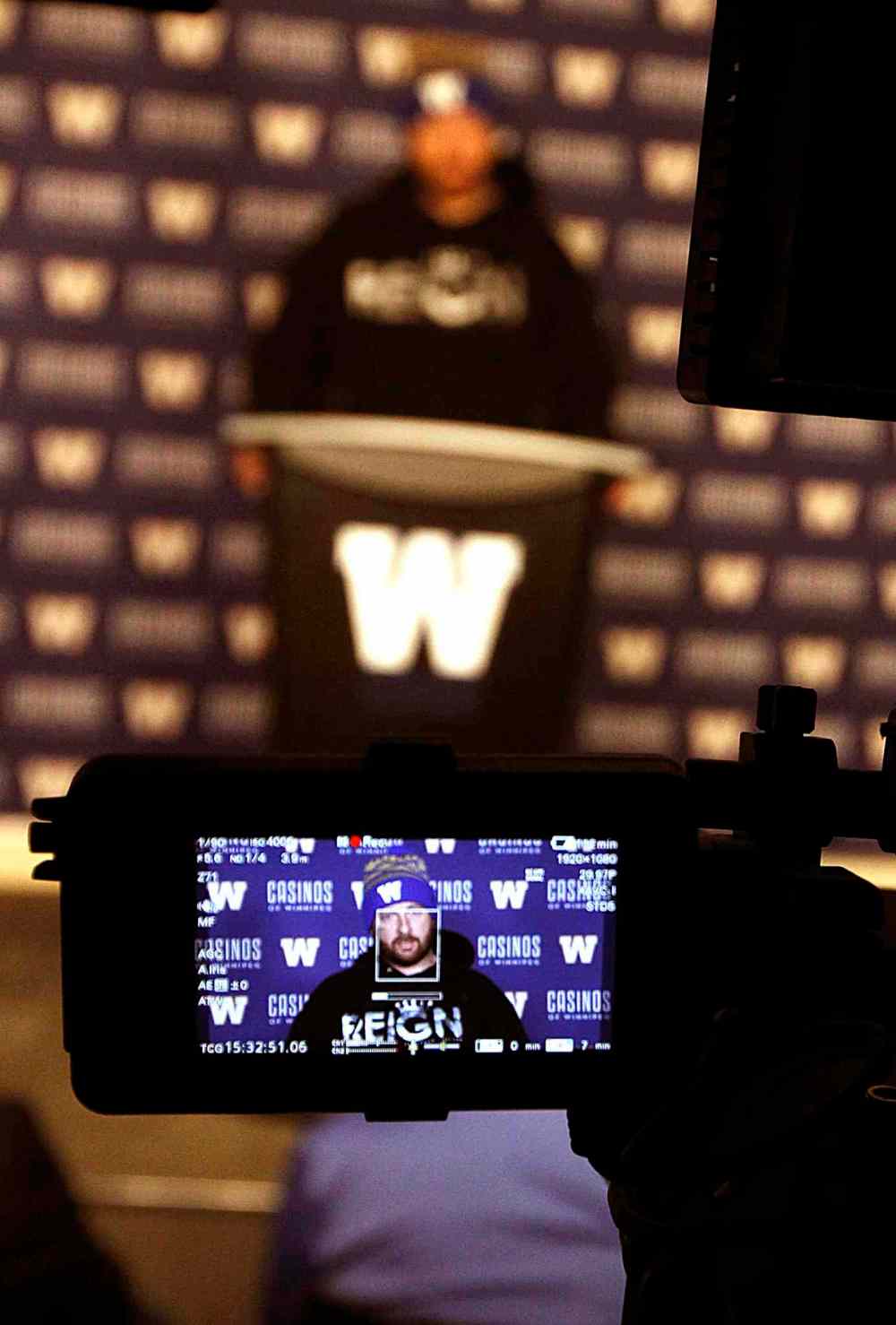Black and Blue, driving for gold With just over a month to go in an outstanding and injury-free CFL season, quarterback Matt Nichols was confidently steering the Blue Bombers toward the playoffs, and then...
Read this article for free:
or
Already have an account? Log in here »
To continue reading, please subscribe:
Monthly Digital Subscription
$0 for the first 4 weeks*
- Enjoy unlimited reading on winnipegfreepress.com
- Read the E-Edition, our digital replica newspaper
- Access News Break, our award-winning app
- Play interactive puzzles
*No charge for 4 weeks then price increases to the regular rate of $19.00 plus GST every four weeks. Offer available to new and qualified returning subscribers only. Cancel any time.
Monthly Digital Subscription
$4.75/week*
- Enjoy unlimited reading on winnipegfreepress.com
- Read the E-Edition, our digital replica newspaper
- Access News Break, our award-winning app
- Play interactive puzzles
*Billed as $19 plus GST every four weeks. Cancel any time.
To continue reading, please subscribe:
Add Free Press access to your Brandon Sun subscription for only an additional
$1 for the first 4 weeks*
*Your next subscription payment will increase by $1.00 and you will be charged $16.99 plus GST for four weeks. After four weeks, your payment will increase to $23.99 plus GST every four weeks.
Read unlimited articles for free today:
or
Already have an account? Log in here »
Hey there, time traveller!
This article was published 21/11/2017 (2941 days ago), so information in it may no longer be current.
Matt Nichols was sitting in a hospital room with his wife, Ali, revelling in the birth of their second child, when the phone rang.
On the other end was close friend and former teammate Mike Reilly, the Edmonton Eskimos’ starting quarterback. Nichols had played with Reilly in Edmonton, the two forming a close bond long before the 2015 Canadian Football League season, when Nichols was shipped east in a trade to the Winnipeg Blue Bombers.
Reilly called to extend his congratulations and once the customary new-baby questions ran dry, the discussion shifted, naturally, to football.
But as a professional courtesy to their respective teams, the upcoming match was hardly discussed; they’d meet in person just 48 hours later at Investors Group Field in the West Division semifinal; Reilly & Co. would beat the Bombers 39-32.
But that was still two days away. Instead, over the phone, the two shared a mutual disappointment over Nichols’ recent string of injuries, with Reilly lamenting how it had prevented Nichols from putting up an honest fight against him in the race to become the league’s most outstanding player. By then, Reilly had already been named the West nominee.
“He’s a competitor, so he was a little bit disappointed that I couldn’t completely be healthy to finish the season out because to win an award like that you want to go against the best that year,” Nichols said in a recent interview with the Free Press.
For Nichols, the frustration went much deeper than personal accolades. Sure, he had a chance to win the CFL’s top award. With a month remaining in the regular season, he led the league in passing touchdowns, had the highest quarterback rating and had thrown the fewest interceptions.
But that was before he suffered a broken finger, which preceded a second-degree strain of his left calf — both of which derailed whatever chance he might have had to top Reilly down the stretch.
What bothered Nichols most about his bad luck wasn’t that he had to leave minutes into a Week 19 loss to the B.C. Lions or that he was forced to watch from the sidelines as the Bombers defeated the Stampeders in Calgary the following week in the regular-season finale. It was that he had to miss any time at all, including the second half of the Hamilton Tiger-Cats game weeks before, in early October — the night he busted his finger.
“That was the most frustrating part, but I felt like I did a good job of managing that, not letting everyone else know just how frustrated I was,” he said.
It wasn’t only Nichols’ teammates that were left in the dark. In fact, they knew a lot more about what was going on with him than those living outside the locker room. The media — and the fans who rely on their reports — knew little more than what could be seen on television replays. For weeks, Nichols and the Bombers kept any and all of his injury details hidden, lowering a curtain of secrecy to prevent any perceived advantage the information might give their opponents.
But with the season now over, there’s no risk in sharing the wild roller-coaster ride Nichols and the coaches were on.

Nichols can’t remember the exact moment during the Oct. 6 home game against Hamilton when his finger was broken, though he has a rough idea.
It could have happened when he was hit by Tiger-Cats defensive end Adrian Tracy — that’s when he first started to feel the pain in his right ring finger. It could have come seconds later, when lying on the turf, he watched another Hamilton player step directly on the same hand.
Most likely, though, it was from a second crushing blow Nichols suffered two drives later, this time from Justin Capicciotti, another Tiger-Cats defensive end. Capicciotti had broken free from the corner and with one swift chop of his arm he “tomahawked the ball away from me and just hit right on that spot again.”
“It was definitely messed up before but that second hit just completely blew my finger up,” Nichols said.
Determined to stay in the game, he retreated to the sidelines in search of another quick fix. The finger had already been taped up following the first hit, so outside of adding more to the damaged digit, the options were limited.
Still, Nichols stayed in the game, completing five of his next seven passes. His eighth, which came as the Bombers were marching into Tiger-Cats territory on the final drive of the first half, seemed to get lost in the night sky by Bombers receiver Ryan Lankford, the play eventually ending in an interception by Hamilton’s Ryan Leonard.
When the Bombers went into the locker room at halftime, it quickly became clear that Nichols would not return. His finger now at full swell, and the pain only getting worse, he tested it one more time before calling it quits.
“When I squeezed the ball it just felt like the ball was flat almost,” said Nichols. “There was just no way I could be accurate that quickly after it happened.”
X-rays the next day revealed the break. The doctor delivering the news feared Nichols might require season-ending surgery. The good news — or bad, depending on how you interpret it — was the injury couldn’t get any worse. So as long as Nichols could withstand the pain, he could play.
Sounds simple, right? Not quite.
Unlike other positions, a quarterback needs to feel all of the fingers on his throwing hand to get a proper grip on the ball. That meant Nichols wouldn’t have the luxury of freezing the finger and it would take some time before he felt comfortable with the pain.
In the event he wouldn’t be able to withstand the pain, the Bombers took the measured precaution of closing the week’s first practice to the public. The privacy, they figured, would prevent whatever questions might arise from reporters had the starting quarterback been forced to leave early. Nichols struggled but was able to last for the entire workout.
“I wasn’t ‘crying’ from it hurting but a single tear would come out of the corner of my eye because it hurt so much,” Nichols said, adding the farther he tried to throw, the more it hurt. “It was just something where the ball came out of my hand fine and was accurate. It was just super painful.”
To help with the pain, Nichols wore a modified glove. The idea came from backup quarterback Dan LeFevour, who said Matt Stafford, the Detroit Lions’ starting quarterback, had done something similar when he injured his finger last season. So Nichols pulled up to his computer and searched for images of “Matt Stafford broken finger.”
What appeared on the screen were pictures of a glove that had every finger cut out but the middle one, which Stafford had dislocated the week before. Mimicking the design, but for his own injury, Nichols cut out the thumb, index and middle, and left the ring and pinky fingers covered. The broken finger was wrapped in tape first for added protection.
“The game against B.C. (Oct. 14) actually felt a lot better than I thought it would,” he said. The Bombers beat the Lions, 26-20, though Nichols, coincidentally, didn’t throw for a single touchdown. “Adrenaline helped a lot with that.”
A week after that, the Bombers travelled to Toronto to take on the Argonauts, with Nichols once again as their starter. At last, he was in the clear. Or so he thought.

Nichols waited on the sidelines at BMO Field in Toronto, watching as Argonauts quarterback Ricky Ray marched his offence downfield. Ray would get as far as the Bombers’ one-yard line before being replaced by backup quarterback Cody Fajardo, who, on his second attempt, broke the plane of the goal line for a touchdown to give Toronto a 29-28 lead.
After the ensuing kickoff, the Bombers had 1:49 left on the clock to orchestrate a game-winning drive. As he jogged onto the field, Nichols said he could feel a tightness starting to form in his left calf. He figured it was a cramp, something he’d experienced before in Toronto, where it’s “usually pretty humid.” The pain, however, only got worse with every step.
“By the time I got out to the huddle it was like, ‘Holy cow, my calf is extremely tight,’” he said.
Not wanting to exit with the game on the line, Nichols fought through the pain. With little time to waste, he wasn’t able to let offensive co-ordinator Paul LaPolice — who was upstairs in the booth calling the next play — know about his calf. Just Nichols’ luck, the first play up was a quarterback draw, meaning he would have to run the ball up the middle unless the Argonauts defence could snuff the play out early.
“It was the first time I ever wanted them to blitz me all at once because I had a hot throw on that if they did,” said Nichols. “That way I wouldn’t have to run the ball.”
Fortunately for Nichols, that’s exactly what Toronto did and, under pressure, he connected with receiver Chris Givens for a 15-yard gain. The Bombers would get to within field-goal range before kicker Justin Medlock missed a potential game-winning 39-yard attempt. Nichols limped to the locker room with the rest of his team.
Nichols said he felt fine the next day, the mild soreness acting merely as confirmation to his original thought that it might be a cramp. To be sure, he underwent daily rehab on it — he was already a regular visitor to the medical room because of the broken finger — but otherwise life was normal and he didn’t miss a single minute of practice.
It wasn’t until the next game, a rematch against the B.C. Lions at home Oct. 28, that it became a serious issue. Unlike in Toronto, Nichols wouldn’t be spared a majority of the game before the pain became unbearable. Instead, he was in trouble in the Bombers’ second offensive series.
He dropped back in the pocket and, as he attempted a half-roll for protection, he felt a sharp pain…
“I honestly thought that we blew a protection inside. It felt like someone dove right into my calf, like someone punched me right in the calf,” he said. “You can see on film I look down to my right real quick before I threw the ball because I thought I was getting tackled.”
At first, he thought he had torn his Achilles. He had heard the horror stories many times before, players describing in great detail what it was like the moment their heel blew up. It seemed to fit the bill — extreme tightness, pain whenever he stepped forward. He was done for the game and later was diagnosed with a second-degree strain of the left calf.

“Any time I tried to go forward with any kind of speed it would just completely ball up on me,” he said. “Obviously I didn’t want to go out there and be a sitting duck when you have first-class athletes that are monsters trying to chase you.”
Full recovery of a second-degree calf strain usually takes somewhere between four and six weeks, but can be as many as eight. The Bombers had just over two weeks before the Eskimos would pay a visit in the West semifinal.
“Once that happened against B.C. it was like we got to shut it down and just rehab hard to make sure I was ready to go for the playoffs,” Nichols said.
That meant staying off the field for at least another week, and away from the media. By doing one, he could achieve the other since players who didn’t practice didn’t have to face reporters’ questions. But it was during that final week of the regular season, on the second day of practice as the Bombers prepared for Calgary with a home playoff game on the line, that Nichols was voted the team’s most outstanding player.
Having not practised the day before and now in front of more than a dozen media members, Nichols was asked if he would be able to play against the Stampeders. He declined to answer, instead echoing an earlier response he had made to a question about his MOP nomination.
In truth, Nichols wasn’t ever going to play against Calgary. He couldn’t even run. He was, however, getting better with each day.
“I was walking completely fine but obviously it was tender to touch,” he said. “Just based on the injury and how I was moving and my range of motion, the doctors felt confident that it would be a lot better and good to play against Edmonton. I put my trust in them and did everything they had me do rehab-wise.”
That included three two-hour rehab sessions a day with Bombers athletic therapist Al Couture. Together, they’d start every morning at 5:30, go again sometime around midday and would meet back at IGF at 7 p.m. for a final nightly run. Each session included massages, workouts in the pool and icing, as well as electrical muscle stimulation.
But it didn’t stop there. Nichols became obsessed with finding more ways to recover faster. Nothing, he said, was off limits.
“I did everything I could find that improved or would build my muscles faster.”
He tried Epsom salt baths and was taking fish oils to help take pressure off his joints. Every day he took a scoop of creatine powder, a muscle-building supplement often used by bodybuilders, as well as a mixture of anti-inflammatory medicine, magnesium and ibuprofen.
“Basically, I had a pharmacy of stuff I had in my backpack with me,” he said.
Nichols went as far to alter his diet in the hope that if he could shed a few pounds it would mean less pressure on his calf. At one point, the team even inquired about speaking with Green Bay Packers quarterback Aaron Rodgers, who has had a history of dealing calf injuries in recent years. But the timing didn’t work out.
In Calgary, Nichols’ hotel room was transformed into a mini hospital ward. While his teammates were checking out the city on their downtime or celebrating the nightlife after a 23-5 win over the Stamps, their starting QB was up in his room, running a circuit of different exercises.
“I felt like if something happened in the playoff game and I couldn’t make it through, I didn’t want to look back and say, ‘I wish I wouldn’t have went and had a beer with the guys.’ I wanted to make sure I was doing everything possible.”

It was all new territory for Nichols, even if he had suffered serious injuries in the past, including a broken leg and a torn knee ligament.
He broke the leg in the 2012 playoffs with the Eskimos and tore up the knee a few months later, during 2013’s pre-season. In both cases, Nichols, strangely enough, took some relief in knowing he’d be out of the game long-term. That way, he could be away from the team and any real or perceived pressure to play, and could focus exclusively on a lengthy rehab.
With the strained calf — and a swift timeline for a return — Nichols was around his teammates every day, and it killed him not practice. He said it was the first time he’s had that feeling in his career, dating back to when he first started playing the game as a kid in the Pop Warner program. He started every game in his four years at Eastern Washington University, never once missing a workout.
“It seemed like such a small thing, because I had been through bigger injuries,” he said.
Knowing his window to recovery was small and not wanting to push it too early, Nichols entered the week ahead of the West semifinal with a tentative plan.
On the first day of practice, he limited himself to just the walkthrough drills. The next day, Nichols and Couture, the team’s head trainer, went out alone onto the field at 5 a.m., in the pitch dark, and Nichols went through his various dropbacks. Three-step. Five-step. Play-action. It was the first real test, and one he would pass with flying colours.

“That was the day I took some actual reps at practice and everything felt great," he said. "I had no problem driving on it, and planting on it was completely normal. That day I knew that it would be fine for the game.”
If the week wasn’t busy enough, Nichols and his wife had a scheduled appointment to have their baby delivered on Friday. They spent the morning together, welcoming Parker Winnie Lou Nichols to the world. Once everything was in the clear and the support group in place, Nichols said he was told to go to practice.
“She’s a football wife. We’ve been together since we were in second year in college. She’s owed a lot of credit for where I am,” said Nichols. “As soon as we were kind of into recovery she was the one saying, ‘I know you don’t want to leave the baby right now, I know you don’t want to leave me, but just go.’
"She’s definitely the best.”
By game time Sunday, Nichols was relatively pain free. He hadn’t tested a full-out sprint and didn’t plan to unless absolutely necessary. He would play mostly within the pocket, finishing the game 35-for-48 passing for 371 yards and three touchdowns in a 39-32 loss. It wasn’t the result he had hoped for, but an effort he felt proud of, given what he had been through in the weeks leading up to the game.
“You want to be out there for your guys,” he said. “Almost every guy, especially after that game, said just how much they appreciated me fighting through that to be out there for them. That stuff goes a long way as a quarterback.”
jeff.hamilton@freepress.mb.ca
twitter: @jeffkhamilton


Jeff Hamilton
Multimedia producer
After a slew of injuries playing hockey that included breaks to the wrist, arm, and collar bone; a tear of the medial collateral ligament in both knees; as well as a collapsed lung, Jeff figured it was a good idea to take his interest in sports off the ice and in to the classroom.
Our newsroom depends on a growing audience of readers to power our journalism. If you are not a paid reader, please consider becoming a subscriber.
Our newsroom depends on its audience of readers to power our journalism. Thank you for your support.
